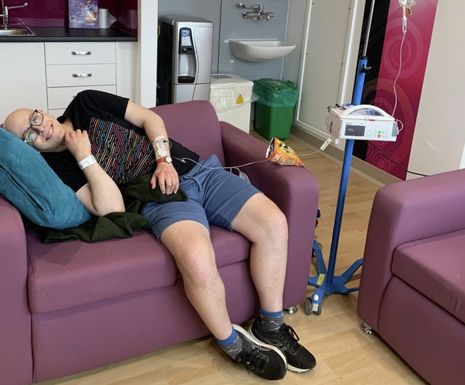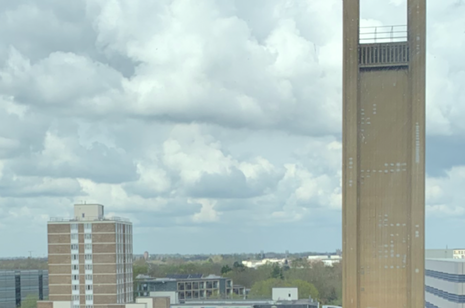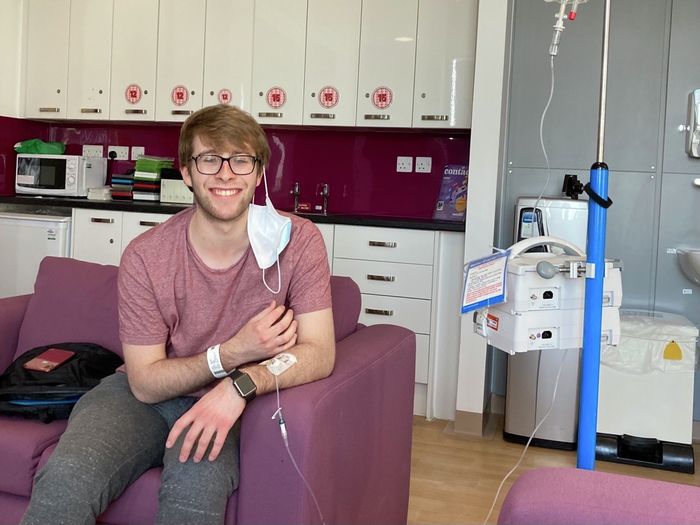Addenbrooks and the UL: The towers of Cambridge
From a cancer ward, Moby Wells explores the liminal space between studenthood and adulthood as he compares the UL to the Addenbrooke’s chimney

I sit and wait for my chemo to start. Through the window of the Day Unit of the Teenage Cancer Ward in Addenbrooke’s, I look north over Cambridge. Two miles away I can see the familiar sight of the University Library, a skyscraper of the Cambridge landscape. Yet, if I straighten my arm out I can cover it with the nail of my little finger.
Beyond its physical size, the UL is a monument to my time at Cambridge. It was the second library I went to in Cambridge and quickly became my favourite. It was more than a study space; it was a labyrinth of dark bookshelves, hidden alcoves, and more books than I could ever conceive.

As a nervous fresher on our induction week, us Caius historians were tasked to each find a particular book. I can’t remember what book it was, but I do remember the mild panic creeping in as I frantically scrambled through dusty shelves. Yet, the satisfaction when I finally found and held the book was immense. By my second term I naively thought I had mastered its twists and turns. Yet when I took a friend the day ended in calamity: as the minutes ticked toward closing time lights began to shut off and doors locked. We escaped, feeling like Indiana Jones, though not without a stern warning from a member of staff not to get lost again.
The UL was an unforgiving teacher in those early months. Entering with a plan to get eight books out, I would frequently leave with three: one was missing, and four I couldn’t find. Over time I improved, becoming adept at negotiating the funny numbers. My growing comfort and familiarity with the UL coincided with a wider development of my character. By third year, I had not only become familiar with the city and the university of Cambridge, I had understood the UL.
“The lessons learnt in the corridors of the UL are not a distant memory”
The UL, like a stern but benevolent parent, watched on. Through countless readings and essays, the hushed bustle of the main reading room was a reassuring constant. Walking to the west of Cambridge, the UL’s church-like prominence was a waypoint from which I could ramble the streets and paths, a guardian beacon that always managed to peek above the trees.
Now, as I sit with my chemo bag pumping toxins into my body to destroy the cancer, the UL remains my visible tether to Cambridge.
I picture those sitting in the main reading room, head down and typing away, mere miles apart but in what may as well be a different world. The thought of what I am missing out on darts around my head like my hands on those dusty shelves.
On the 5th of March I rushed to A&E following a phone call which said that a shadowy mass could be seen in my x-ray. I was told that the chance I would be staying the night was low — I ended up remaining in the C9 ward for three nights.
“The corridors of Addenbrooke’s, with the confusing array of wards and floors are my new library”
I’ve only returned to Caius’ Old Courts once since. As I walked into my room I thought about Chernobyl, of the teddy bears, books, clothes, sitting ready and poised to be used again. My air dryer stood to attention: the last time I had touched it was when I was naive about my health. My soap bottle was half empty, the trip to the shop to replace it now rendered unnecessary.
A term away from my final exams, the movement from student to “the real world” was something that had been on my mind. In some ways the surprise upheaval of the cancer diagnosis has made things easier for me. It has put me in a liminal space between student and post-student life. On one hand, I continued my dissertation, and on the other, my room is now an empty shell that I won’t return to. Like shed snake skin, my scribbled dissertation post-it notes lay curled and long past their usefulness.
Yet this has all taught me that the shift to “adult life” is not so stark. The lessons learnt in the corridors of the UL are not a distant memory. The corridors of Addenbrooke’s, with the confusing array of wards and floors are my new library. The Day Unit’s staccato taps harmonise with the memory of the percussive orchestra of the main reading room. And the physical prominence of the UL? That has been replaced by Addenbrooke’s 220 metre chimney.
My mum calls it the “church of recovery”. Built in 1970, it rises above the flat roofs of the hospital, a beacon in another sense, shining its light on a hopeful future. As we travel over the Gog Magog hills the first sight of the hospital is the chimney, a waypoint for my path to recovery. Life changes, progresses, and is full of surprises. Plans that seem chiselled in stone can become just as easily eroded. Change is exciting.
So as I sit with chemo pumping into me, I can see my old life and this new one, the UL and the chimney, side by side.
To follow Moby’s story, see his Instagram: @the_companion_planters
 News / Uni Scout and Guide Club affirms trans inclusion 12 December 2025
News / Uni Scout and Guide Club affirms trans inclusion 12 December 2025 News / Cambridge Vet School gets lifeline year to stay accredited28 November 2025
News / Cambridge Vet School gets lifeline year to stay accredited28 November 2025 News / Cambridge study finds students learn better with notes than AI13 December 2025
News / Cambridge study finds students learn better with notes than AI13 December 2025 Science / Did your ex trip on King’s Parade? The science behind the ‘ick’12 December 2025
Science / Did your ex trip on King’s Parade? The science behind the ‘ick’12 December 2025 News / Pembroke to convert listed office building into accom9 December 2025
News / Pembroke to convert listed office building into accom9 December 2025








